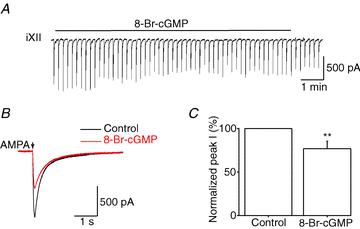Protein kinase G-dependent mechanisms modulate hypoglossal motoneuronal excitability and long-term facilitation
- PMID: 20855434
- PMCID: PMC3008849
- DOI: 10.1113/jphysiol.2010.194209
Protein kinase G-dependent mechanisms modulate hypoglossal motoneuronal excitability and long-term facilitation
Abstract
Since protein kinase-dependent modulation of motoneuronal excitability contributes to adaptive changes in breathing, we hypothesized that cGMP-dependent pathways activating protein kinase G (PKG) modulate motoneuronal inspiratory drive currents and long-term plasticity. In a medullary slice preparation from neonatal rat (postnatal days 0-4) generating spontaneous respiratory-related rhythm, hypoglossal (XII) motoneuronal inspiratory drive currents and respiratory-related XII nerve activity were recorded. Focal application of a PKG activator, 8-bromoguanosine-3',5'-cyclomonophosphate (8-Br-cGMP), to voltage-clamped XII motoneurones decreased inspiratory drive currents. In the presence of tetrodotoxin (TTX), 8-Br-cGMP decreased the exogenous postsynaptic inward currents induced by focal application of AMPA. Intracellular dialysis of XII motoneurones with an inhibitory peptide to PKG (PKGI) increased endogenous inspiratory-drive currents and exogenous AMPA-induced currents. Application of 8-Br-cGMP with PKGI had no further effect on spontaneous or evoked currents, confirming that the observed effects were induced by PKG. However, PKG differentially increased longer-term plasticity. Three 3 min applications (separated by 5 min) of the α(1)-adrenergic agonist phenylephrine (PE) in combination with 8-Br-cGMP yielded greater in vitro long-term facilitation than PE alone. These data indicate the presence of a cGMP/PKG-dependent signalling pathway in XII motoneurones that modulates inspiratory drive currents and plasticity of XII motoneurones, possibly contributing to their adaptation during physiological challenges, such as sleep and exercise.
Figures





Similar articles
-
Dynamic interactions of excitatory and inhibitory inputs in hypoglossal motoneurones: respiratory phasing and modulation by PKA.J Physiol. 2004 Feb 1;554(Pt 3):879-89. doi: 10.1113/jphysiol.2003.054528. Epub 2003 Dec 5. J Physiol. 2004. PMID: 14660708 Free PMC article.
-
Dynamic modulation of inspiratory drive currents by protein kinase A and protein phosphatases in functionally active motoneurons.J Neurosci. 2003 Feb 15;23(4):1099-103. doi: 10.1523/JNEUROSCI.23-04-01099.2003. J Neurosci. 2003. PMID: 12598595 Free PMC article.
-
Modulation of hypoglossal motoneuron excitability by NK1 receptor activation in neonatal mice in vitro.J Physiol. 2001 Jul 15;534(Pt. 2):447-64. doi: 10.1111/j.1469-7793.2001.00447.x. J Physiol. 2001. PMID: 11454963 Free PMC article.
-
Modulation of hypoglossal motoneuron excitability by intracellular signal transduction cascades.Respir Physiol Neurobiol. 2005 Jul 28;147(2-3):131-43. doi: 10.1016/j.resp.2005.03.014. Respir Physiol Neurobiol. 2005. PMID: 15893504 Review.
-
Sequential activation of soluble guanylate cyclase, protein kinase G and cGMP-degrading phosphodiesterase is necessary for proper induction of long-term potentiation in CA1 of hippocampus. Alterations in hyperammonemia.Neurochem Int. 2004 Nov;45(6):895-901. doi: 10.1016/j.neuint.2004.03.020. Neurochem Int. 2004. PMID: 15312984 Review.
Cited by
-
Effect of chronic intermittent hypoxia on noradrenergic activation of hypoglossal motoneurons.J Appl Physiol (1985). 2012 Jan;112(2):305-12. doi: 10.1152/japplphysiol.00697.2011. Epub 2011 Oct 20. J Appl Physiol (1985). 2012. PMID: 22016369 Free PMC article.
-
Regulation of respiratory-related hypoglossal motor output by α₁ adrenergic and serotonin 5-HT₃ receptor activation in isolated adult turtle brainstems.Respir Physiol Neurobiol. 2012 Apr 30;181(2):202-13. doi: 10.1016/j.resp.2012.03.004. Epub 2012 Mar 16. Respir Physiol Neurobiol. 2012. PMID: 22446563 Free PMC article.
References
-
- Aoki CRA, Liu H, Downey GP, Mitchell J, Horner RL. Cyclic nucleotides modulate genioglossus and hypoglossal responses to excitatory inputs in rats. Am J Respir Crit Care Med. 2006;173:555–565. - PubMed
-
- Arancio O, Kiebler M, Lee CJ, Lev-Ram V, Tsien RY, Kandel ER, Hawkins RD. Nitric oxide acts directly in the presynaptic neuron to produce long-term potentiation in cultured hippocampal neurons. Cell. 1996;87:1025–1035. - PubMed
-
- Babcock M, Badr M. Long-term facilitation of ventilation in humans during NREM sleep. Sleep. 1998;21:709–716. - PubMed
Publication types
MeSH terms
Substances
Grants and funding
LinkOut - more resources
Full Text Sources

